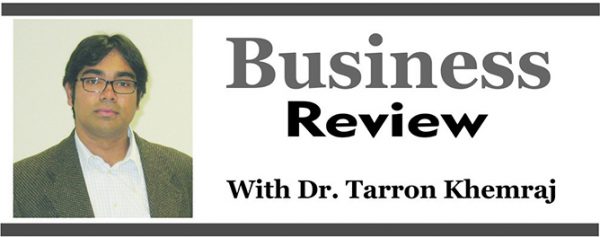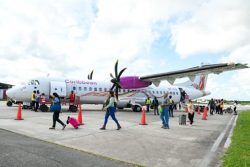 The informal or underground economy has been the source of tremendous speculation and political controversy. Some folks see the narco-economy as synonymous with the underground economy. Gold smuggling is often excluded from the discussion, as well as the incomes not reported for the purpose of escaping from paying taxes. State asset recovery is often conflated with the underground economy (see KN 01/06/2016 “Guyana’s underground economy accounts for $188B”). Yet another example of mixing up several forms of corruption is the newspaper report: “Guyana was losing over $300B annually through corruption under PPP” (KN 16/02/2017). No thought was spared for the fact that gold production – and the under declaration – has diverse political representation as one can infer from the 2017 EITI report.
The informal or underground economy has been the source of tremendous speculation and political controversy. Some folks see the narco-economy as synonymous with the underground economy. Gold smuggling is often excluded from the discussion, as well as the incomes not reported for the purpose of escaping from paying taxes. State asset recovery is often conflated with the underground economy (see KN 01/06/2016 “Guyana’s underground economy accounts for $188B”). Yet another example of mixing up several forms of corruption is the newspaper report: “Guyana was losing over $300B annually through corruption under PPP” (KN 16/02/2017). No thought was spared for the fact that gold production – and the under declaration – has diverse political representation as one can infer from the 2017 EITI report.
Perhaps conflating these different forms of corruption provides the justification for establishing a politically rent-seeking agency like SARA. In later essays I will explore how politics influences business investments.
The coalition government has indeed acted on some of these beliefs by rescinding a few large land concessions granted under the PPP/C government and redistributed these to perhaps two large non-political investors and several supporters – in keeping with the new era of pacific and pride patronage (I will also develop these two forms of patronage systems in the next few columns on “The rise of the Grangerian land-based plutocracy”). None of this is surprising; we have already noted in these columns that the historical ethno-political contestation between PPP/C and PNC (straggler AFC has its own careerist incentives) is rooted in economic motives. The underground economy – which really took off in the 1980s – is a useful political tool for instilling confusion and blame as the two sides tussle to control land and other resources.
There have been various attempts over the years to estimate the size of the underground economy. The best estimate I have seen, using appropriate technical tools, was done in 2017 by Dr. Amos Peters of the Inter-American Development Bank (IDB). The paper is also useful because it compares the underground economy in Guyana with several other Caribbean economies: The Bahamas, Barbados, Jamaica, Suriname, and Trinidad and Tobago. The period of analysis for the countries started in 1990 and ended in 2014. This means we have a good assessment over the period of the previous administration. Underground production is structural; therefore, we expect these estimates to also apply to the rate of the hidden economy under APNU+AFC.
It is important to note that the econometric estimates are aggregates and cannot tell anything about the composition of the underground economy. In other words, we cannot say what percentage is made up of narco-trafficking, gold smuggling and other otherwise legal production that are hidden in order to evade paying taxes. The percentage composition I will give are, therefore, guesstimates.
In general, the IDB paper found nothing unusual about Guyana’s aggregate underground economy over the review period. For example, the estimate for Barbados ranges from 30% to 40% of official GDP; 35% to 44% for Jamaica; 35% to 45% in Suriname; 26% to 33% in Trinidad and Tobago; and the lowest at 20% to 30% in The Bahamas. In the case of Guyana, the estimate is 29% to 33% of official GDP. Previous to this IDB study, one newspaper article had reported that the underground sector is 60% in Guyana. However, no credible methodology was suggested by the newspaper indicating how it came up with that number.
Let us assume that the size in Guyana is 31% of official GDP, which is the midpoint estimate from the Peters study. Also, assume there has been no change in the percentage rate since the coalition government came to power – a perfectly reasonable assumption given that narco-trafficking is just one component of the illegal production. My estimate of Guyana’s GDP at end 2018 is approximately US$3.2 billion. This means that there was US$984 million of underground activities in 2018.
Exactly what is the composition of that US$984 million is the great mystery. What is the percentage of gold and diamond smuggling? Narco-trafficking? Self-employed professionals and service-based producers not reporting income and production? No one really knows, but one highly educated former intelligence officer thinks that annual narco-trafficking is between US$100 million to US$150 million per year.
It was reported some time ago that Minister Trotman has intelligence that 15,000 ounces of gold are smuggled out of Guyana each week. This means that about 780,000 thousand ounces are smuggled out each year – representing a market value of over US$900 million. Even a more conservative estimate puts gold smuggling at around US$500 million annually.
Apart from explaining the composition of the underground economy, gold is your classic “lootable” extractive resource. It should be no surprise this sector is likely the primary driver of non-declared production that otherwise would be legal. It is a manifestation of the natural resource curse (NRC) playing out in Guyana for a long time before first oil.
If one wants to explore the growth impact of the underground economy, one has to specify the transmission channel through which the gold-inspired NRC shapes skills formation in the economy. In general, smuggling embodies “skills” necessary to disappear the production across the border – such as bribing police and other officials, undermining political confidence, capturing and corrupting politicians, and getting regulations and laws written to benefit the sector. The pusherman “skillset” also involves tying up resources and buying up land and buildings and entrenching a rentier cost layer on top of the already high cost of business, which is associated with the ecological system and historical settlement patterns.
However, the kind of skills required to diversify the use of the sugarcane feedstock away from bulk sugar involve various types of engineers, chemists, agronomists, biologists, economists, accountants and similar educated and trained professionals. It will require machinists, mechanics, heavy machine operators, chefs, etc., as well as internships for university students. The skills needed to have a local non-profit university attracting about 3,000 foreign students from the Caribbean, Central America and South America are enormous. The positive technical, educational and social spillovers from these kinds of production would be revolutionary. However, university professors are a pesky lot for resource-rich politicians who first must secure the ethnic base and also choose who gets patronage from the other side.
Both activities – gold smuggling and narco-trafficking – can generate economic growth as can the non-profit university or the diversified GuySuCo. In the short-term, the pusherman-engendered growth can even be faster. But eventually the system is handicapped by the adverse spillovers from underground activities. The skills-based growth could be slower in a country like Guyana with a small market, but it will be more sustainable. It is the right path to pursue.
Before closing this column, I should say it must never be assumed that someone who gets rich quickly is either smuggling narcotics or precious metals. One can become a billionaire in Guyana dollars in a short time if one has political access and becomes the only importer of a good. This would be an example of earning rents by gaining the monopoly right from a politician. In turn, the person has to donate political contributions to the party which granted the right and also buy a few gifts off the books for the politician. These activities certainly add another layer of cost for other businesses. And if someone has monopoly rights to import good X, then any effort to manufacture X in Guyana will be stifled.
Do you think it is by accident the Guyanese political class – eager to tie up offshore oil blocks through two ethnic networks – refused to consider seriously an E10 mandate to save GuySuCo?
Comments can be made at tkhemraj@ncf.edu





